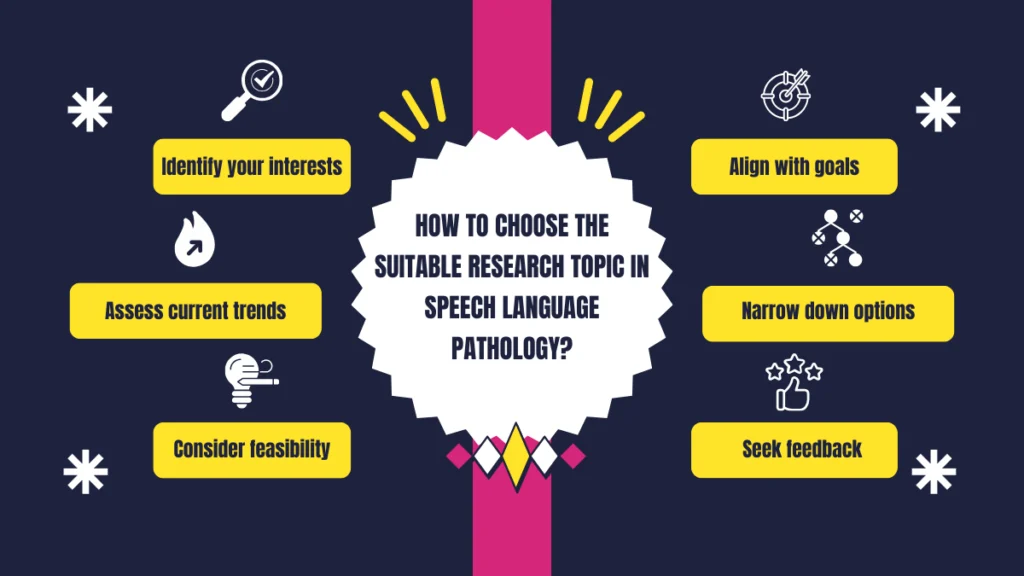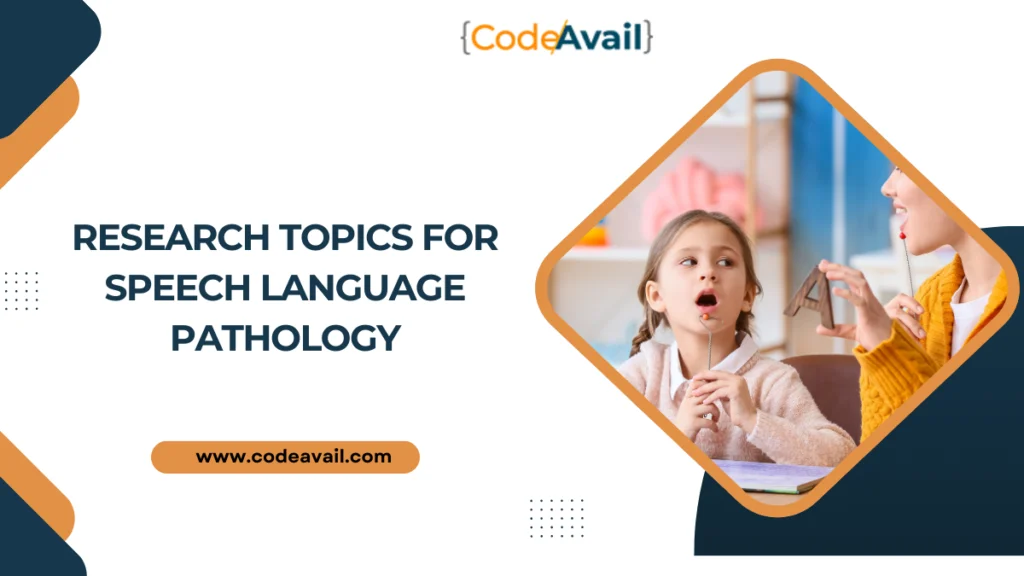Did you know that about 1 in every 12 kids in the United States has a problem with talking or understanding? This big number shows how important it is to help kids with these issues early.
Speech-language pathology covers a lot of different ways to help people who have trouble talking or swallowing, no matter how old they are. From little kids just learning to talk to older people struggling with language problems, SLP professionals help a lot of different kinds of people.
Research in speech-language pathology is super important because it helps develop new ideas and better ways to help patients. By trying out new therapies, seeing if treatments work well, and understanding how talking problems happen, researchers improve things for patients and those who help them.
In this blog, we’ll talk about some really interesting research topics for speech language pathology. We’ll look at things researchers are studying that could change how we help people with talking problems and make their lives better.
What Exactly Does Speech Language Pathology Mean?
Table of Contents
Speech Language Pathology (SLP) is a field focused on diagnosing, assessing, and treating disorders related to communication and swallowing.
SLP professionals, often known as speech therapists, work with individuals of all ages to address issues such as speech articulation, language development, voice disorders, fluency problems (like stuttering), and difficulties with swallowing.
They use various techniques and therapies to help clients improve their communication skills and enhance their quality of life.
Additionally, SLPs may work in diverse settings, including schools, hospitals, rehabilitation centers, and private practices, providing tailored interventions to meet the unique needs of each client.
| Also Read: Feminist Research Topics |
How to Choose the Suitable Research Topic In Speech Language Pathology?
Choosing a suitable research topic in speech-language pathology (SLP) involves considering several factors to ensure relevance, feasibility, and potential impact. Here are some steps to help you select an appropriate research topic:

1. Identify your interests
Consider what aspects of Speech Language Pathology (SLP) intrigue you the most, whether it’s language development, cognitive-communication, fluency disorders, swallowing difficulties, or another area.
2. Assess current trends
Stay updated on recent advancements and emerging topics in SLP research through academic journals, conferences, and discussions within the field.
3. Consider feasibility
Evaluate the resources available to you, including access to data, equipment, and mentorship, to ensure that your chosen research topic is achievable within your constraints.
4. Align with goals
Ensure that your research topic aligns with your academic or professional goals, whether it’s fulfilling degree requirements, contributing to the field, or addressing a specific clinical need.
5. Narrow down options
Narrow your focus by selecting a specific aspect or question within your chosen area of interest that you can realistically explore within the scope of your research project.
6. Seek feedback
Discuss your potential research topics with peers, professors, or SLP professionals to gather insights and perspectives that can help you refine your ideas and make an informed decision.
List of Research Topics for Speech Language Pathology
Here’s a list of research topics for speech-language pathology across various areas of interest and specialization:
Language Development
- The role of parental interaction in language development.
- Language acquisition in bilingual children.
- Effects of early intervention on language development in children with autism spectrum disorder.
- Assessing the impact of socioeconomic status on language skills in preschoolers.
- Language development in children with hearing impairments.
- The efficacy of storytelling in promoting language skills in preschoolers.
- Intervention strategies for late talkers.
- Language development in children with specific language impairment.
- Long-term outcomes of early language intervention programs.
- The influence of technology on language development in children.
Cognitive Communication
- Cognitive-communication deficits in traumatic brain injury patients.
- The relationship between executive function and language skills in older adults.
- Cognitive-communication interventions for individuals with dementia.
- Cognitive-communication challenges in stroke survivors.
- The impact of attention deficits on language processing.
- Cognitive-communication strategies for individuals with aphasia.
- Cognitive-communication assessment tools for adolescents.
- The role of memory in language comprehension.
- Cognitive-communication therapy for individuals with Parkinson’s disease.
- Cognitive-communication difficulties in individuals with ADHD.
Fluency Disorders
- Neurobiological mechanisms of stuttering.
- The efficacy of fluency shaping techniques in treating stuttering.
- Early predictors of persistent stuttering in children.
- Emotional and psychological impacts of stuttering.
- The effectiveness of teletherapy for individuals who stutter.
- Genetic factors contribute to stuttering.
- Stigma and social attitudes towards individuals who stutter.
- Impact of fluency disorders on academic and social functioning.
- The role of anxiety in stuttering.
- Treatment outcomes of different therapy approaches for stuttering.
Swallowing Disorders
- Dysphagia assessment techniques in stroke patients.
- The efficacy of neuromuscular electrical stimulation in dysphagia treatment.
- Dysphagia management in head and neck cancer patients.
- Swallowing disorders in Parkinson’s disease.
- Effects of aging on swallowing function.
- Dysphagia interventions in children with cerebral palsy.
- The impact of dysphagia on nutritional status and quality of life.
- Complications and risk factors associated with dysphagia.
- The role of posture and positioning in dysphagia therapy.
- Rehabilitation strategies for oropharyngeal dysphagia.
Voice Disorders
- Vocal hygiene practices in preventing voice disorders.
- The efficacy of voice therapy for vocal nodules.
- Voice disorders in teachers: Prevalence and interventions.
- Psychological factors contributing to functional voice disorders.
- Vocal fold paralysis: Diagnosis and treatment options.
- Effects of hormone therapy on voice quality in transgender individuals.
- Vocal fatigue in professional voice users.
- The role of laryngeal imaging in voice assessment.
- Vocal rehabilitation following laryngectomy.
- Alternative and augmentative communication devices for individuals with severe voice disorders.
Autism Spectrum Disorders (ASD)
- Communication interventions for nonverbal individuals with ASD.
- Social communication deficits in children with ASD.
- Sensory processing and communication in ASD.
- Effects of early intervention on communication skills in children with ASD.
- Peer-mediated interventions for promoting social communication in children with ASD.
- The relationship between restricted interests and language development in ASD.
- Augmentative and alternative communication (AAC) strategies for individuals with ASD.
- Theory of mind and its implications for communication in ASD.
- The role of play-based therapy in promoting communication skills in children with ASD.
- Parent training programs for enhancing communication in children with ASD.
Augmentative and Alternative Communication (AAC)
- AAC interventions for individuals with acquired communication disorders.
- Access methods for AAC devices: Evaluating efficacy and usability.
- Multimodal communication systems for individuals with severe disabilities.
- AAC strategies for individuals with degenerative diseases.
- Personalized vocabulary selection for AAC users.
- The impact of AAC on social participation and quality of life.
- Training programs for caregivers and communication partners of AAC users.
- Integration of AAC devices in educational settings.
- The effectiveness of aided vs. unaided AAC systems.
- AAC technology trends and innovations.
Literacy and Language Disorders
- Reading comprehension strategies for children with language disorders.
- Phonological awareness interventions for children at risk of reading difficulties.
- The role of vocabulary knowledge in reading comprehension.
- Language-based literacy interventions for children with dyslexia.
- Relationship between oral language skills and literacy development.
- The impact of narrative skills on reading comprehension.
- Executive function and its influence on literacy acquisition.
- The effectiveness of computer-assisted literacy interventions.
- Language-literacy connections in bilingual children.
- Literacy interventions for adolescents with language disorders.
Cultural and Linguistic Diversity
- Cultural considerations in assessment and intervention for bilingual children.
- Communication challenges in multicultural populations.
- The impact of language dominance on assessment results in bilingual individuals.
- Culturally responsive therapy approaches in Speech-Language Pathology.
- Bilingualism and cognitive advantages: Exploring the evidence.
- Language brokering experiences of bilingual adolescents.
- Integrating cultural competence into graduate SLP education.
- The influence of cultural beliefs and practices on communication disorders.
- Addressing language barriers in healthcare settings.
- Community-based approaches to supporting communication in multicultural populations.
Technology and Innovation
- Telepractice in Speech-Language Pathology: Efficacy and accessibility.
- Augmented reality applications for language therapy.
- Wearable technology for monitoring speech and swallowing function.
- Artificial intelligence in speech and language assessment.
- Virtual reality interventions for individuals with communication disorders.
- Mobile applications for speech therapy: Usability and effectiveness.
- Voice recognition technology for AAC users.
- Robotics-assisted therapy for individuals with motor speech disorders.
- Gamification of speech and language interventions.
- Emerging trends in assistive technology for communication disorders.
These topics cover a range of issues and areas within speech-language pathology, from clinical interventions to theoretical investigations. Depending on your interests and expertise, you can further refine these topics or explore related areas to develop your research focus.
| Also Read: Criminal Justice Research Topics |
Ethical Considerations in SLP Research Topics
Ethical considerations are paramount in any research endeavor, including speech-language pathology (SLP). Here are some key ethical considerations to keep in mind when conducting research in this field:
- Informed consent: Ensure that participants fully understand the research procedures, risks, and benefits before agreeing to participate.
- Confidentiality: Safeguard the privacy of participants by securely storing and anonymizing data to prevent unauthorized access.
- Respect for autonomy: Respect the autonomy and self-determination of individuals with communication disorders, ensuring their right to make informed decisions.
- Avoidance of harm: Minimize potential harm to participants through careful design and implementation of research protocols.
- Cultural sensitivity: Recognize and respect cultural differences and individual preferences when conducting research with diverse populations.
- Conflict of interest: Disclose any potential conflicts of interest that may influence the research process or outcomes.
- Transparency: Maintain transparency in reporting research findings, including any limitations or biases in the study.
- Collaboration: Foster collaboration and communication among researchers, participants, and relevant stakeholders to ensure ethical conduct throughout the research process.
Promising Directions and Future Prospects In Research Topics for Speech Language Pathology
Research in speech-language pathology (SLP) continually evolves, with promising directions and future prospects emerging in various areas. Here are some promising directions and future prospects in research topics for SLP:
- Technology integration: Continued exploration of innovative technologies, such as telepractice, virtual reality, and wearable devices, to enhance assessment and intervention methods.
- Personalized therapy approaches: Development of tailored interventions based on individual needs, preferences, and characteristics to optimize outcomes.
- Multidisciplinary collaboration: Increasing collaboration with other disciplines, such as neuroscience and engineering, to advance understanding and treatment of communication disorders.
- Cultural competence: Integrating cultural competence training and awareness into research and clinical practice to better serve diverse populations.
- Longitudinal studies: Conduct longitudinal studies to track the effectiveness of interventions over time and understand the long-term impacts of communication disorders.
Final Thoughts
The field of Speech Language Pathology offers a rich landscape of research topics that hold immense promise for advancing our understanding and treatment of communication disorders.
Through interdisciplinary collaboration, technological innovation, and a commitment to ethical practice, researchers continue to uncover new insights and develop effective interventions to improve the lives of individuals with speech and language challenges.
As we embark on this journey of discovery, let us remain vigilant in addressing the diverse needs of our communities and fostering a culture of inclusivity and respect.
Together, we can pave the way toward a future where communication barriers are overcome, and every voice is heard.
FAQs
1. How can I find inspiration for research topics in speech-language pathology?
Explore areas of personal interest, stay updated with current issues in the field, and consider collaborating with colleagues for diverse perspectives.
2. How does research in SLP translate to clinical practice?
Research findings inform assessment and treatment approaches, guiding speech-language pathologists in providing evidence-based care to their clients.
3. What are some emerging areas of research in speech-language pathology?
Emerging areas include telepractice, cultural and linguistic diversity, neuroplasticity, and the use of technology in assessment and intervention.
4. Where can I find resources for identifying research topics in SLP?
Utilize academic journals, professional conferences, online databases, and networking opportunities with colleagues and mentors.


